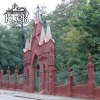Католицька частина байкового цвинтаря
Байкова 6
Ця частина цвинтаря заснована в 1833 році, нові частині з 1876 року. Тут поховані відомі поляки: лікарі В.Віскович та Л. Гурецький, фотограф та поет В. Висоцький, батько П. Жмигродського, видавець Л. Ідзіковський, художник В. Котарбінський, магнат М. Понятовський, державний діяч та філантроп С. Сірочинський, польскі легіонери 1920 року та багато інших.
Були склепи відомих польских родин. Герсилія Ідзиковська – видавець та дружина Леона Ідзиковського, фундатора відомого київського видавництва (заснована 1859).
- Приміщення навчальних закладів
- Житловий будинок
- Житловий будинок, у якому жив Болеслав Лесьмян
- Молодий театр, Будинок громадських закладів
- Приміщення київського Літературно-артистичного товариства
- Місце де було приміщення Театру польського
- Пам'ятний знак
- Національна філармонія
- Особняк Божкова
- Житловий будинок, в якому жили художники
- Римо-католицька лікарня
- Будинок з Химерами
- Маріїнський палац
- Прибутковий будинок Римо-католицького товариства
- Місце де була бібліотека та магазин
- Жовтий корпус університету
- бібліотека НаУКМА
- Філія Національної бібліотеки України імені В.Вернадського
- Костел Святого Олександра
- Меморіал Жертвам репресій 1937-194 рр.
